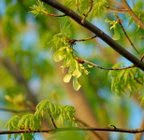I have a fascination with Oklahoma's genius loci. It seems that somewhere after the landrun Oklahoma's identity was lost. We have a pretty good sense of Oklahoma before the landrun. Even if it is not historically accurate or it has a Hollywood sheen to it. What caused this identity crisis?
Is it possible to nail down the spirit of Oklahoma with it's incredible diversity? Is it actually its diversity that dispersed or watered-down its spirit? Is it Oklahoma's relatively young age that it has not developed a strong genius loci and we are still in the adolescent stages of its spirit?
What comes to mind when thinking of Oklahoma? What images? Oklahoma City? Tulsa? Ardmore? Durant? Ada? The state as whole? What picture is conjured up when we think of Oklahoma in relationship to its neighbors? Kansas? Missouri? Arkansas? Texas? Colorado and New Mexico? Do those states bring instant images of spirit to mind? Wheat fields? The Ozarks? The Rocky's? The South West?
I wonder if the loss of the prairie ecosystem in the last hundred years has changed the genius loci? The buffalo, the native peoples, the groundhog, the fauna and flora. The prairie was dependant on fire. Without fire and grazers came the trees--elms, hackberry, eastern red cedar and more. I know that the surrounding states also eliminated fire in their ecosystems, but how has it affected their genius loci? Was the prairie the heart of their identities? Maybe my thoughts should lead me more to prairie states and how they have reconciled prairie and identity.
If the prairie is an integral part of our genius loci how do we embrace it? What are the key characteristics of Oklahoma's spirit and soul? I'm sure I'll have more thoughts on the prairie.
I had a professor that directed me to the world fairs as a way to try and interpret some of these issues. The world fairs were an opportunity for Oklahoman's to express their genius loci to the world. They are not timeless exhibits, but they do express the spirit of the Oklahoman people at a specific time. They also express relationships of the land and their neighbors.
World's Columbian Exposition of 1893
Here is the Joint Territorial Building of The World's Columbian Exposition of 1893. Oklahoma was still a Territory and this building represented Arizona, New Mexico and Oklahoma.
http://columbus.iit.edu/dreamcity/1500/00044073.JPG
Arizona, New Mexico, and Oklahoma jointly occupy a long, low, two-story building, a garden upon its flat roof displaying the typical vegetation of the southwest. Beds and columns of gigantic cacti are arranged in front of this structure, its plain veranda surmounted by a balcony, with plants in large vessels along the railing, overshadowing the entrance-ways to the headquarters of the three territories. To a certain extent the small exhibition rooms are a duplication of that which was displayed in the general departments, and among them are mineral specimens from New Mexico and Arizona, with the grains and vegetables of Oklahoma. Int eh second story are parlors nearly furnished and not without evidences of artistic taste. In New Mexico’s chamber are beautiful specimens of woman’s work, including that which comes from the Navajos, and here are also paintings of more than average merit. Among Arizona’s collection is a life size crayon portrait of General Crook, and near it a picture of an old log-house built in Prescott in 1863, the pioneer building of that locality and the residence of the first governor. In photographic form are other historic spots, with several views of the Grand canon. There is also a collection of pottery from one of the Indian agencies, and from the wife of General O’Neil comes a quilt in which are reproduced the corps badges of the United States army.source
OKLAHOMA'S PAVILION IN THE AGRICULTURAL BUILDING - As may be seen at a glance in the engraving, the new Territory of Oklahoma erected one of the most peculiar and characteristic pavilions to be found among the oddities and fancies of the cereal architects in Chief Buchanan's large domain. This section was situated prominently in the first aisle away from the west wall, at the southwest corner of the main building. Sorghum and corn served as the principal materials of the builder, and canopied many other displays. From the ceiling depended great bunches of grasses, and a pyramid of jars formed the central feature of the exhibit. Cane, cereals and vegetables were displayed with a profusion that led the visitor to marvel upon the swift march of agriculture across the "Great American Desert," which was a central tract in all school geographies of Lincoln's time. The Territory of Oklahoma was settled while the last World's Fair was in the midst of its splendor at Paris, in 1889, and sat here among sister States in 1893 as visible as were they, occupying as much space, courting as much attention, receiving as many visitors, hoping to gain as many new residents. The National Commissioners of Oklahoma were Pthniel Beeson, of El Reno, and Frank R. Gammon, of Guthrie; the Alternate Commissioners were John Wallace, of Oklahoma City, and Joseph W. McNeal, of Guthrie. Mrs. Guthrie was one of the Lady Managers, and Mrs. Beeson was her colleague.
1904 St. Louis World's Fair
The Louisiana Purchase ExpositionHospitality is a trait that all Oklahomans possess and the territorial building seemed to have been constructed with the one idea in mind, of having abundant room and comfort for guests. Two big verandas extended along the front of the structure and in the cloistered recesses were all kinds of chairs and couches inviting the tired to rest. On the first floor was a wide reception hall with parlors on either side. A stairway lead to more rooms and a balcony on the second floor. Through an elliptical opening, surrounded by an ornamental railing the visitor had a full view of the scenes below. Displays of art and history were made in the decorations, one of the features being a series of portraits of all the Governors of the Territory. A register was kept for the signatures of visitors and in the same rooms was a file of Oklahoma newspapers, as well as facilities for writing letters. Natural woods supplied beautiful furnishings for the interior and Oklahoma cement was used in the exterior work. The roof was of red tile, giving a touch of the Moorish to what would otherwise be a Spanish style of architecture. The building was surrounded by sheltering trees and New York was Oklahoma's nearest neighbor to the east. The building measured 76 by 70 feet, cost $16,000 and was dedicated May 23, 1904.
The Columbian Exhibit expresses our Southwest influences in landscape and our western front in building. Both the Columbian and the St. Louis exhibit were well attended and helped shape the national perceptions of Oklahoma. The fairs were not that far apart. Oklahoma hold to the Spanish and Southwest influences in both exhibits.
The St. Louis exhibit is especially interesting in trying to understand our attitudes and where we were in the world in 1904. By the way, this building was moved and is still standing in El Reno. I looked through my files for a current picture, but it has evaded me. I believe it is the Elk's Lodge. Key words and ideas in this building: Hospitality, welcoming and inviting, Spanish/Moorish architecture. Interestingly surrounded by trees. The tree issue will have to be another post on Simon Schama's book Landscape and Memory and his idea of "Our connotation of trees and value or equity." Maybe that is why the prairie was passed over in favor of further west. How was the designer trying to express Oklahoma with this building?I worked on a transportation project in studio for Oklahoma City. During this project I tried to tease out this idea of "What makes Oklahoma, Oklahoma?". With each project I do I try to investigate further the notion of regional and local spirit.enlarged linkThat project also folded in transportation.
This whole topic is thick and complex. I have much more to read and explore about Oklahoma: ancient culture to the present, oil, climate, politics, the environment, our neighbors, wind and horizon....the list goes on. I will add to it with GENIUS LOCI 1.2




